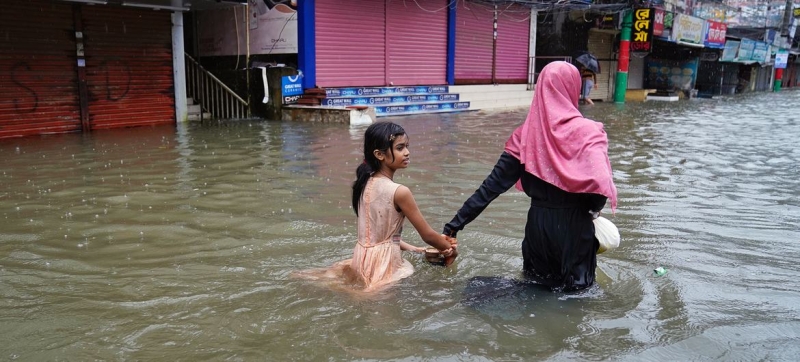- 30 NCP leaders urge Nahid Islam not to form alliance with Jamaat |
- Tarique offers fateha at graves of Pilkhana martyrs, father-in-law |
- Navy detains 11 over smuggling diesel, cement to Myanmar |
- Investors stay away as stocks turnover drops 7% despite index gains |
- No immediate funds for merged bank depositors, B.B. |
Climate Summit 2025: The Path to COP30

A mother guides her daughter through floodwaters in Feni, Bangladesh. © UNICEF/Sultan Mahmud Mukut
Floods in South Asia, wildfires across North America, and record-breaking heat in Europe have underscored what scientists have warned for years: climate change is escalating faster than the political response. Against this backdrop, the UN Secretary-General is holding a climate summit during the high-level week of the General Assembly, pressing nations to raise their climate pledges ahead of November’s UN climate conference (COP30) in Belém, Brazil.
The summit, which takes place on 24 September at UN Headquarters, is designed as a launchpad for COP30 but, unlike the sprawling negotiations of a UN climate conference, this is a targeted high-level event where Heads of State, government leaders, businesses, and civil society are expected to present concrete pledges and new national climate plans.
‘Bold action for the next decade’
According to the organisers, the summit has a clear mandate: parties to the Paris Agreement – the landmark 2015 climate change treaty – must bring forward new or updated NDCs (Nationally Determined Contributions, or pledges to take measures to address the climate crisis) that reflect “bold action for the next decade.”
UN chief António Guterres has made it plain: existing pledges are nowhere near sufficient, and only a fraction of member states have up-to-date NDCs for 2025. Current national plans, according to the UNFCCC, would only cut global emissions by 2.6 per cent by 2030 compared to 2019 levels, a tiny fraction of the 43 per cent reduction that scientists say is needed to keep global temperatures to no more than 1.5 degrees Celsius above pre-industrial levels.
The summit therefore serves as both a pressure point and an opportunity. Leaders are expected not just to restate commitments, but to announce new NDCs, show how they will be implemented, and highlight how they align with the accelerating clean energy transition.
Why now?
The urgency of the summit is sharpened by both scientific and political realities. The UN World Meteorological Organization reported that 2024 was the hottest year on record, with average global temperatures 1.6 degrees Celsius above pre-industrial levels. Meanwhile, the international political landscape has grown more fractured.
The United States, which withdrew from the Paris Agreement in early 2025, remains one of the largest historical emitters. Its retreat from climate finance and clean-energy commitments has left developing nations questioning whether the promised flows of support will materialise.
At the same time, real momentum exists. Clean energy investment topped $2 trillion in 2024, outpacing fossil fuels for the first time, and initiatives such as the proposed Fossil Fuel Non-Proliferation Treaty are gaining traction. The summit will test whether these positive trends can be harnessed and scaled.
Reading between the lines
The Climate Summit is not a negotiating session, but its outcomes will set the tone for COP30 in Belém. Brazil has promised to centre that conference on climate justice, forest protection, and renewable energy. Yet success in Belém will depend heavily on what happens in New York this week.
Observers will watch closely for three signals. First, will major emitters bring plans that close the emissions gap? Second, is climate finance scaled up beyond symbolic pledges, especially for the Loss and Damage Fund (which has attracted just under $789 million in pledges so far, far short of what is needed)? And finally, will leaders acknowledge that expanding coal, oil, and gas is incompatible with Paris targets?
Without progress on these fronts, COP30 risks becoming another forum of unmet expectations.
High stakes
For the UN chief, the summit is about more than process. It is about rebuilding trust in multilateralism at a time when global divides are widening and demonstrating that climate action can unlock economic and social benefits. “The opportunities of climate action have never been clearer,” the UN has stressed, pointing to job creation, health improvements, and energy security linked to clean energy expansion.
Still, for communities in Pakistan and India displaced by destructive floods, or for farmers in the Horn of Africa facing drought, the summit is less about opportunity than survival. The gap between climate impacts and the political response has never felt wider.
From words to action
The UN Climate Summit of September 2025 is not a substitute for COP30, but it may prove just as decisive. It is the arena where leaders can reset ambition, inject credibility, and build momentum toward Brazil.
If it can deliver bold new pledges, credible finance, and a clear direction on fossil fuels, it could help salvage the promise of Paris.

